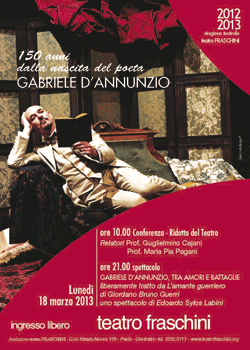Essays Current Research ReviewsContributorsAnnouncements
Home
D’Annunzio: a Hero for Contemporary Italian Theatre
Maria Pia Pagani
 2013 marks the 150th anniversary of Gabriele d’Annunzio’s birth. For this occasion, his life as a central figure of Italian history and literature at the turn of the nineteenth century is narrated in the play Gabriele d’Annunzio, tra amori e battaglie, written by Edoardo Sylos Labini and Francesco Sala, with Giordano Bruno Guerri, the poet’s most important biographer and president of Vittoriale (www.vittoriale.it), serving as a consultant.
2013 marks the 150th anniversary of Gabriele d’Annunzio’s birth. For this occasion, his life as a central figure of Italian history and literature at the turn of the nineteenth century is narrated in the play Gabriele d’Annunzio, tra amori e battaglie, written by Edoardo Sylos Labini and Francesco Sala, with Giordano Bruno Guerri, the poet’s most important biographer and president of Vittoriale (www.vittoriale.it), serving as a consultant.
The play is based on Guerri’s book L’amante guerriero (Milan: Mondadori, 2008) and presents d’Annunzio as an artist who was able to realize his dreams in a whirl of love, passion, infidelity, political and social adventures, poetic provocations, and a taste of victory.
The setting faithfully reproduces the rooms of Vittoriale, where the poet (Edoardo Sylos Labini) pays homage to the most important women in his life: his wife, Maria Hardouin d’Altemps (Alice Viglioglia), the pianist Luisa Baccara (Silvia Siravo), the housekeeper Amélie Mazoyer, called Aélis (Giorgia Sinicorni) and, above all, the great actor Eleonora Duse (Viola Pornaro).
The personal and creative relationship with Duse helps d’Annunzio to test new forms of development for Italian theatre at the turn of the nineteenth century, even though their efforts are not always understood and appreciated by the audiences. In the play, the poet agrees to write The Dead City (La Città Morta) for Eleonora and reveals his skill as a director, but decides to commit the première to her rival, Sarah Bernhardt, in Paris, in 1898.
Although often disappointed by his behaviour, Eleonora firmly believes in Gabriele’s talent and agrees to the publication of the novel The Flame of Life (Il Fuoco) in 1900; she knows that the most intimate details of their relationship (her problems with her age; her jealousy of the younger women surrounding the poet) would be public, but she does not want to stop the creation of a masterpiece of Italian literature.
Eleonora is the person who understands Gabriele best, encourages and supports him. Many years later, Gabriele admits that Eleonora was the woman who had loved him the most, and remembers her on his deathbed. In fact, at the end of the play, at the moment of his death, Eleonora receives Gabriele with open arms in the new life, eternity.
In the play, music, which was, along with his love of women, the fundamental source of poetic inspiration for d’Annunzio, is mixed live by DJ Antonello Aprea using modern equipment and accompanies the reading of passages from The Child of Pleasure (Il piacere), Nocturne (Notturno), The Flame of Life (Il Fuoco). Even the most famous poem, “The Rain in the Pinewood (La Pioggia nel Pineto),” is performed in a very original electronic version, and presents one of the most intense tests of the skill of the actor Edoardo Sylos Labini.
In Gabriele d’Annunzio, tra amori e battaglie, we have a very interesting portrait of a hero of Italian contemporary theatre and a man who is to this day able to communicate his love for art, literature, and life.